The Investigation of the Influence of a Cu2O Buffer Layer on Hole Transport Layers in MAPbI3-Based Perovskite Solar Cells
Abstract
:1. Introduction
2. Device Structure and Simulation Parameters
3. Result and Discussion
3.1. Reference Device Performance
3.2. Effect of Cu2O Buffer Layer on Various Metal Electrodes
3.3. The Effect of a Cu2O Buffer Layer with HTLs
3.4. The Optimization of Cu2O, Absorber Layer, and PTAA Thickness
3.5. The Effect of Interface Layer Defect
4. Conclusions
Supplementary Materials
Author Contributions
Funding
Institutional Review Board Statement
Informed Consent Statement
Data Availability Statement
Acknowledgments
Conflicts of Interest
References
- Stranks, S.; Eperon, G.; Grancini, G.; Menelaou, C.; Alcocer, M.; Leijtens, T.; Herz, L.; Petrozza, A.; Snaith, H. Electron-Hole Diffusion Lengths Exceeding 1 Micrometer in an Organometal Trihalide Perovskite Absorber. Science 2013, 342, 341–344. [Google Scholar] [CrossRef] [PubMed] [Green Version]
- Shrotriya, V.; Li, G.; Yao, Y.; Chu, C.; Yang, Y. Transition metal oxides as the buffer layer for polymer photovoltaic cells. Appl. Phys. Lett. 2006, 88, 073508. [Google Scholar] [CrossRef] [Green Version]
- Chen, Y.; Tang, Y.; Chen, P.; Zhang, L.; Liu, Q.; Zhao, Y.; Huang, Q.; Zhang, X. Progress in perovskite solar cells based on different buffer layer materials. Acta. Phys. Sin. 2020, 69, 138401. [Google Scholar] [CrossRef]
- Arora, N.; Dar, M.; Hinderhofer, A.; Pellet, N.; Schreiber, F.; Zakeeruddin, S.; Gratzel, M. Perovskite solar cells with CuSCN hole extraction layers yield stabilized efficiencies greater than 20%. Science 2017, 358, 768–771. [Google Scholar] [CrossRef] [Green Version]
- Zhou, J.; Liu, P.; Du, Y.; Zong, W.; Zhang, B.; Liu, Y.; Xu, S.; Cao, S. Evident Enhancement of Efficiency and Stability in Perovskite Solar Cells with Triphenylamine-Based Macromolecules on the CuSCN Hole-Transporting Layer. J. Electron. Mater. 2021, 50, 3962–3971. [Google Scholar] [CrossRef]
- Zilberberg, K.; Meyer, J.; Riedl, T. Solution processed metal-oxides for organic electronic devices. J. Mater. Chem. C 2013, 1, 4796–4815. [Google Scholar] [CrossRef]
- Cai, C.; Zhou, K.; Guo, H.; Pei, Y.; Hu, Z.; Zhang, J.; Zhu, Y. Enhanced Hole extraction by NiO Nanoparticles in carbon-based perovskite solar cells. Electrochim. Acta. 2019, 312, 100–108. [Google Scholar] [CrossRef]
- Zhao, Y.; Nardes, A.; Zhu, K. Effective hole extraction using MoOx-Al contact in perovskite CH3NH3PbI3 solar cells. Appl. Phys. Lett. 2014, 104, 213906. [Google Scholar] [CrossRef]
- Gnaser, H. Energy and Angular Distributions of Sputtered Species. Sputtering by Particle Bombardment; Behrisch, R., Eckstein, W., Eds.; Springer: Berlin/Heidelberg, Germany, 2007; Volume 110, pp. 231–328. [Google Scholar]
- Hou, Y.; Du, X.; Scheiner, S.; McMeekin, D.P.; Wang, Z.; Li, N.; Killian, M.S.; Chen, H.; Richter, M.; Levchuk, I.; et al. A Generic Interface to Reduce the Efficiency-Stability-Cost Gap of Perovskite Solar Cells. Science 2017, 358, 1192–1197. [Google Scholar] [CrossRef] [Green Version]
- Ramos, F.; Jutteau, S.; Posada, J.; Bercegol, A.; Rebai, A.; Guillemot, T.; Bodeux, R.; Schneider, N.; Loones, N.; Ory, D.; et al. Highly Efficient MoOx-Free Semitransparent Perovskite Cell for 4 T Tandem Application Improving the Efficiency of Commercially-Available Al-BSF Silicon. Sci. Rep. 2018, 8, 16139. [Google Scholar] [CrossRef]
- Wang, Y.; Xia, Z.; Liang, J.; Wang, X.; Liu, Y.; Liu, C.; Zhang, S.; Zhou, H. Towards printed perovskite solar cells with cuprous oxide hole transporting layers: A theoretical design. Semicond. Sci. Technol. 2015, 30, 054004. [Google Scholar] [CrossRef]
- Kim, J.; Liang, P.; Williams, S.; Cho, N.; Chueh, C.; Glaz, M.; Ginger, D.; Jen, A. High-Performance and Environmentally Stable Planar Heterojunction Perovskite Solar Cells Based on a Solution-Processed Copper-Doped Nickel Oxide Hole-Transporting Layer. Adv. Mater. 2015, 27, 695–701. [Google Scholar] [CrossRef] [PubMed]
- Chatterjee, S.; Pal, A. Introducing Cu2O Thin Films as a Hole-Transport Layer in Efficient Planar Perovskite Solar Cell Structures. J. Phys. Chem. C 2016, 120, 1428–1437. [Google Scholar] [CrossRef]
- Iivonen, T.; Heikkila, M.J.; Popov, G.; Nieminen, H.; Kaipio, M.; Kemell, M.; Mattinen, M.; Meinander, K.; Mizohata, K.; Raisanen, J.; et al. Atomic Layer Deposition of photoconductive Cu2O Thin Films. ACS Omega. 2019, 4, 11205–11214. [Google Scholar] [CrossRef] [PubMed] [Green Version]
- Islam, M.; Sobayel, K.; Al-Kahtani, A.; Islam, M.; Muhammad, G.; Amin, N.; Shaiduzzaman, M.; Akhtaruzzaman, M. Defect Study and Modelling of SnX3-Based Perovskite Solar Cells with SCAPS-1D. Nanomaterials 2021, 11, 1218. [Google Scholar] [CrossRef] [PubMed]
- Du, H.; Wang, W.; Zhu, J.Z. Device simulation of lead-free CH3NH3SnI3 perovskite solar cells with high efficiency. Chin. Phys. B 2016, 25, 108802. [Google Scholar] [CrossRef]
- Jannat, F.; Ahmed, S.; Alim, M. Performance analysis of cesium formamidinium lead mixed halide based perovskite solar cell with MoOx as hole transport material via SCAPS-1D. Optik 2021, 228, 166202. [Google Scholar] [CrossRef]
- Raoui, Y.; Ez-Zahraouy, H.; Tahiri, N.; El Bounagui, O.; Ahmad, S.; Kazim, S. Performance analysis of MAPbI (3) based perovskite solar cells employing diverse charge selective contacts: Simulation study. Sol. Energy 2019, 193, 948–955. [Google Scholar] [CrossRef]
- Du, H.; Wang, W.; Gu, Y. Simulation design of P–I–N-type all-perovskite solar cells with high efficiency. Chin. Phys. B 2017, 26, 028803. [Google Scholar] [CrossRef]
- Karthick, S.; Boucle, J.; Velumani, S. Effect of bismuth iodide (BiI3) interfacial layer with different HTL’s in FAPI based perovskite solar cell-SCAPS-1D study. Sol. Energy 2021, 218, 157–168. [Google Scholar] [CrossRef]
- Lin, L.; Jiang, L.Q.; Li, P.; Xiong, H.; Kang, Z.; Fan, B.D.; Qiu, Y. Simulated development and optimized performance of CsPbI3 based all-inorganic perovskite solar cells. Sol. Energy 2020, 198, 454–460. [Google Scholar] [CrossRef]
- Sun, C.; Mroz, M.; Smirnov, J.; Luer, L.; Hermida-Merino, D.; Zhao, C.; Takeuchi, M.; Sugiyasu, K.; Cabanillas-Gozalez, J. Amplified spontaneous emission in insulated polythiophenes. J. Mater. Chem. C 2019, 6, 6591–6596. [Google Scholar] [CrossRef]
- Isakova, A.; Karuthedath, S.; Arnold, T.; Howse, J.; Topham, P.; Toolan, D.; Laquai, F.; Luer, L. Efficient long-range electron transfer processes in polyfluorene–perylene diimide blends. Nanoscale 2018, 10, 10934–10944. [Google Scholar] [CrossRef]
- Karuthedath, S.; Sauermann, T.; Egelhaaf, H.; Wannemacher, R.; Brabec, C.; Luer, L. The effect of oxygen induced degradation on charge carrier dynamics in P3HT: PCBM and Si-PCPDTBT: PCBM thin films and solar cells. J. Mater. Chem. A 2015, 3, 3399–3408. [Google Scholar] [CrossRef] [Green Version]
- Xu, W.; Daunis, T.B.; Piper, R.; Hsu, J. Effects of photonic curing processing conditions on MAPbI3 film properties and solar cell performance. ACS A.E.M. 2020, 3, 8636–8645. [Google Scholar] [CrossRef]
- Yang, W.; Noh, J.; Jeon, N.; Kim, Y.; Ryu, S.; Seo, J.; Seok, S. High-performance photovoltaic perovskite layers fabricated through intramolecular exchange. Science 2015, 348, 1234–1237. [Google Scholar] [CrossRef] [PubMed]
- Deng, K.; Chen, Q.; Li, L. Modification Engineering in SnO2 Electron Transport Layer toward Perovskite Solar Cells: Efficiency and Stability. Adv. Funct. Mater. 2020, 30, 2004209. [Google Scholar] [CrossRef]
- Li, F.; Xu, M.; Ma, X.; Shen, L.; Zhu, L.; Weng, Y.; Yue, G.; Tan, F.; Chen, C. UV Treatment of Low-Temperature Processed SnO2 Electron Transport Layers for Planar Perovskite Solar Cells. Nanoscale Res. Lett. 2018, 13, 216. [Google Scholar] [CrossRef]
- Bag, A.; Radhakrishman, R.; Nekovei, R.; Jeyakumar, R. Effect of absorber layer, hole transport layer thicknesses, and its doping density on the performance of perovskite solar cells by device simulation. Sol. Energy 2019, 196, 177–182. [Google Scholar] [CrossRef]
- Karimi, E.; Ghorashi, S. The Effect of SnO2 and ZnO on the Performance of Perovskite Solar Cells. J. Electron. Mater. 2020, 49, 364–376. [Google Scholar] [CrossRef]
- Zhao, P.; Lin, Z.; Wang, J.; Yue, M.; Su, J.; Zhang, J.; Chang, J. Numerical Simulation of Planar Heterojunction Perovskite Solar Cells Based on SnO2 Electron Transport Layer. ACS Appl. Energy Mater. 2019, 2, 4504–4512. [Google Scholar] [CrossRef]
- Li, J.; Dong, Q.; Li, N.; Wang, L. Direct Evidence of Ion Diffusion for the Silver-Electrode Induced Thermal Degradation of Inverted Perovskite Solar Cells. Adv. Energy Mater. 2017, 7, 14. [Google Scholar] [CrossRef]
- Chavali, M.; Nikolova, M. Metal oxide nanoparticles and their applications in nanotechnology. SN Appl. Sci. 2019, 1, 1–30. [Google Scholar] [CrossRef] [Green Version]
- Yip, H.; Hau, S.; Baek, N.; Ma, H.; Jen, A. Polymer solar cells that use self-assembled-monolayer-modified ZnO/metals as cathodes. Adv. Mater. 2008, 20, 2376. [Google Scholar] [CrossRef]
- Lin, M.Y.; Lee, C.Y.; Shiu, S.C.; Wang, J.; Sun, J.Y.; Wu, W.H.; Lin, Y.; Huang, J.; Lin, C. Sol–gel processed CuOx thin film as an anode interlayer for inverted polymer solar cells. Org. Electron. 2010, 11, 1828–1834. [Google Scholar] [CrossRef]
- Sun, J.; Zhang, Y.; Wu, J.; Yang, Q.; Yu, G.; Yang, X.; Ying, Z.; Sheng, J.; He, Y.; Shou, C. An Efficient Modification at the Hole Transporting Layer/Electrode Interface for High-Performance Ag-Electrode-Based Perovskite Solar Cells. Phys. Status Solidi A 2022, 19, 200272. [Google Scholar] [CrossRef]
- Jayan, K.; Sebastain, V. Comprehensive device modelling and performance analysis of MASnI (3) based perovskite solar cells with diverse ETM, HTM and back metal contacts. Sol. Energy 2021, 217, 40–48. [Google Scholar] [CrossRef]
- Azri, F.; Meftah, A.; Sengouga, N.; Meftah, A. Electron and hole transport layers optimization by numerical simulation of a perovskite solar cell. Sol. Energy 2019, 181, 372–378. [Google Scholar] [CrossRef]
- Zuo, L.; Guo, H.; deQuilettes, D.; Jariwala, S.; De Marco, N.; Dong, S.; Deblock, R.; Ginger, D.; Dunn, B.; Wang, M.; et al. Polymer-modified Halide Perovskite Films for Efficient and Stable Planar Heterojunction Solar Cells. Sci. Adv. 2017, 3, e1700106. [Google Scholar] [CrossRef] [Green Version]
- Coulibaly, A.; Oyedele, S.; Aka, B. Comparative study of lead-free perovskite solar cells using different hole transporter materials. Model. Numer. Simul. Mater. Sci. 2019, 9, 97–107. [Google Scholar] [CrossRef]
- Zhao, J.; Zheng, X.; Deng, Y.; Li, T.; Shao, Y.; Gruverman, A.; Shiled, J.; Huang, J. Is Cu a stable electrode material in hybrid perovskite solar cells for a 30-year lifetime. Energy Environ. Sci. 2016, 9, 3650–3656. [Google Scholar] [CrossRef]
- Haque, F.; Yi, H.; Lim, J.; Lim, J.; Dua, L.; Pham, H.; Sonar, P.; Uddin, A. Small molecular material as an interfacial layer in hybrid inverted structure perovskite solar cells. Mater. Sci. Semicond. Process. 2020, 108, 104908. [Google Scholar] [CrossRef]
- Jeong, M.; Choi, I.; Go, E.; Cho, Y.; Kim, M.; Lee, B.; Jeong, S.; Jo, Y.; Choi, H.; Lee, J. Stable perovskite solar cells with efficiency exceeding 24.8% and 0.3-V voltage loss. Science 2020, 369, 1615–1620. [Google Scholar] [CrossRef]
- Shi, J.; Wei, H.; Zhu, L.; Xu, X.; Xu, Y.; Lu, S.T.; Wu, H.; Luo, Y.; Li, D.; Meng, Q. S-shaped current-voltage characteristics in perovskite solar cell. Acta. Phys. Sin. 2015, 64, 038402. [Google Scholar] [CrossRef]
- Xu, Z.; Li, N.; Liu, X.; Liu, H.; Liu, G.; Chen, Q.; Zhou, H. Balancing Energy-Level Difference for Efficient n-i-p Perovskite Solar Cells with Cu Electrode. Energy Mat. Adv. 2022, 8, 9781073. [Google Scholar] [CrossRef]
- Chakraborty, K.; Choudhury, M.; Paul, S. Numerical study of Cs2TiX6 (X = Br−, I−, F− and Cl−) based perovskite solar cell using SCAPS-1D device simulation. Sol. Energy 2019, 194, 886–892. [Google Scholar] [CrossRef]
- Gupta, G.K.; Dixit, A. Simulation studies on photovoltaic response of ultrathin CuSb(S/Se) (2) ternary compound semiconductors absorber-based single junction solar cells. Int. J. Energy Res. 2021, 44, 3724–3736. [Google Scholar] [CrossRef]
- Raoui, Y.; Kazim, S.; Galagan, Y.; Ez-Zahraouy, H.; Ahmad, S. Harnessing the potential of lead-free Sn–Ge based perovskite solar cells by unlocking the recombination channels. Sustain. Energy Fuels. 2021, 5, 4661–4667. [Google Scholar] [CrossRef]
- Karimi, E.; Ghorashi, S. Investigation of the Influence of Different Hole-Transporting Materials on the Performance of Perovskite Solar Cells. Optik 2017, 130, 650–658. [Google Scholar] [CrossRef]
- Chowdhury, M.; Shahahmadi, S.; Chelvanathan, P.; Tiong, S.; Amin, N.; Techatoet, K.; Nuthammachot, N.; Chowdhuty, T.; Sulklueng, M. Effect of Deep-Level Defect Density of the Absorber Layer and n/i Interface in Perovskite Solar Cells by SCAPS-1D. Results Phys. 2020, 16, 102839. [Google Scholar] [CrossRef]
- Wu, G.; Li, X.; Zhou, J.; Zhang, J.; Zhang, X.; Leng, X.; Wang, P.; Chen, M.; Zhao, K.; Zhang, Y. Fine Multi-phase Alignments in 2D Perovskite Solar Cells with Efficiency over 17% via Slow Post-Annealing. Adv. Mater. 2019, 31, 1903889. [Google Scholar] [CrossRef] [PubMed]
- Yousuf, M.; Saeed, F.; Tauqeer, H. Numerical Investigation of Cu2O as Hole Transport Layer for High- Efficiency CIGS Solar Cell. Preprints 2021, 2021100326. [Google Scholar] [CrossRef]
- Jagt, R.; Huq, T.; Hill, S.; Thway, M.; Liu, T.; Napari, M.; Roose, B.; Galkowski, K.; Li, W.; Lin, S. Rapid vapor-phase deposition of high-mobility p-type buffer layers on perovskite photovoltaics for efficient semitransparent devices. ACS Energy Lett. 2020, 5, 2456–2465. [Google Scholar] [CrossRef]
- Kim, H.; Lim, K.; Lee, T. Planar heterojunction organometal halide perovskite solar cells: Roles of interfacial layers. Energy Environ. Sci. 2016, 9, 12–30. [Google Scholar] [CrossRef]
- Canestraro, C.; Oliveira, M.; Valaski, R.; da Silva, M.; David, D.; Pepe, I.; da Silva, A.; Roman, L.; Persson, C. Strong inter-conduction-band absorption in heavily fluorine doped tin oxide. Appl. Surf. Sci. 2008, 255, 1874–1879. [Google Scholar] [CrossRef]
- Kumar, A.; Gahlaut, P.; Gupta, N. Highly efficient tin oxide-based colloidal lead sulfide quantum dot solar cell. Energy Stor. Mater. 2022, e331. [Google Scholar] [CrossRef]
- Loper, P.; Stuckelberger, M.; Niesen, B.; Wener, J.; Filipic, M.; Moon, S.; Yum, J.; Topic, M.; De Wolf, S.; Ballif, C. Complex Refractive Index Spectra of CH3NH3PbI3 Perovskite Thin Films Determined by Spectroscopic Ellipsometry and Spectrophotometry. Jpn. J. Appl. Phys. 2015, 6, 66–71. [Google Scholar] [CrossRef]
- Chen, H.; Bryant, D.; Troughton, J.; Kirkus, M.; Neophytou, M.; Miao, X.; Durrant, J.; McCulloch, I. One-Step Facile Synthesis of a Simple Hole Transport Material for Efficient Perovskite Solar Cells. Chem. Mater. 2016, 28, 2515–2518. [Google Scholar] [CrossRef] [Green Version]
- Yu, W.; Li, F.; Wang, H.; Alarousu, E.; Chen, Y.; Lin, B.; Wang, L.; Hedhili, M.; Li, Y.; Wu, K. Ultrathin Cu2O as an efficient inorganic hole transporting material for perovskite solar cells. Nanoscale 2016, 8, 6173–6179. [Google Scholar] [CrossRef] [Green Version]
- Mohamed, S.; Gasiorowski, J.; Hingerl, K.; Zahn, D.; Scharber, M.; Obayya, A.; El-Mansy, M.; Sariciftci, N.; Egbe, D.; Stadler, P. CuI as versatile hole-selective contact for organic solar cell based on anthracene-containing PPE–PPV. Sol. Energy Mater. Sol. Cells 2015, 143, 369–374. [Google Scholar] [CrossRef]
- Liu, J.; Pathak, S.; Sakai, N.; Sheng, R.; Bai, S.; Wang, Z.; Snaith, H. Identification and Mitigation of a Critical Interfacial Instability in Perovskite Solar Cells Employing Copper Thiocyanate Hole-Transporter. Adv. Mater. Interfaces 2016, 3, 1600571. [Google Scholar] [CrossRef]
- Masumura, K.; Nakanishi, I.; Khuat, K.; Kinashi, K.; Sakai, W.; Tsutsumi, N. Optimal composition of the poly(triarylamine)-based polymer composite to maximize photorefractive performance. Sci. Rep. 2019, 9, 739. [Google Scholar] [CrossRef] [PubMed] [Green Version]
- Ahmed, R. Effect of Gold Nanoparticles on the Physical Properties of Poly (3,4-ethylenendioxythiophene): Poly (styrene sulphonate) and its Gas Sensor Application. Arab J. Nuc. Sci. Appl. 2018, 51, 9–18. [Google Scholar] [CrossRef] [Green Version]
- Cook, S.; Furube, A.; Katoh, R. Analysis of the excited states of regioregular polythiophene P3HT. Energy Environ. Sci. 2008, 1, 294–299. [Google Scholar] [CrossRef]
- Ming, W.; Yang, D.; Li, T.; Zhang, L.; Du, M. Formation and Diffusion of Metal Impurities in Perovskite Solar Cell Material CH3NH3PbI3: Implications on Solar Cell Degradation and Choice of Electrode. Adv. Sci. 2018, 5, 1700662. [Google Scholar] [CrossRef] [PubMed] [Green Version]
- Kanoun, A.; Kanoun, B.; Merad, A.; Goumri-Said, S. Toward development of high-performance perovskite solar cells based on CH3NH3GeI3 using computational approach. Sol. Energy 2019, 182, 237–244. [Google Scholar] [CrossRef]
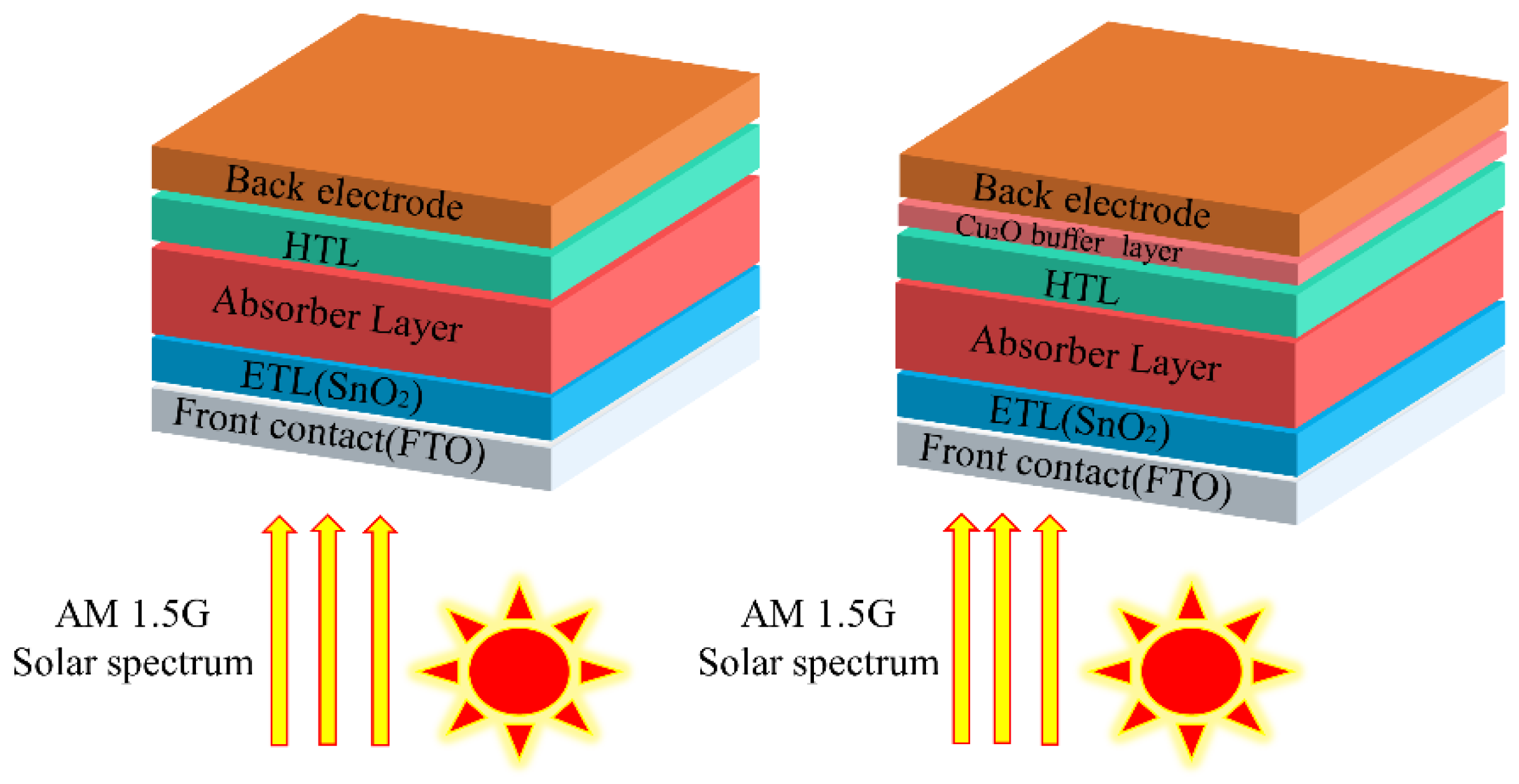

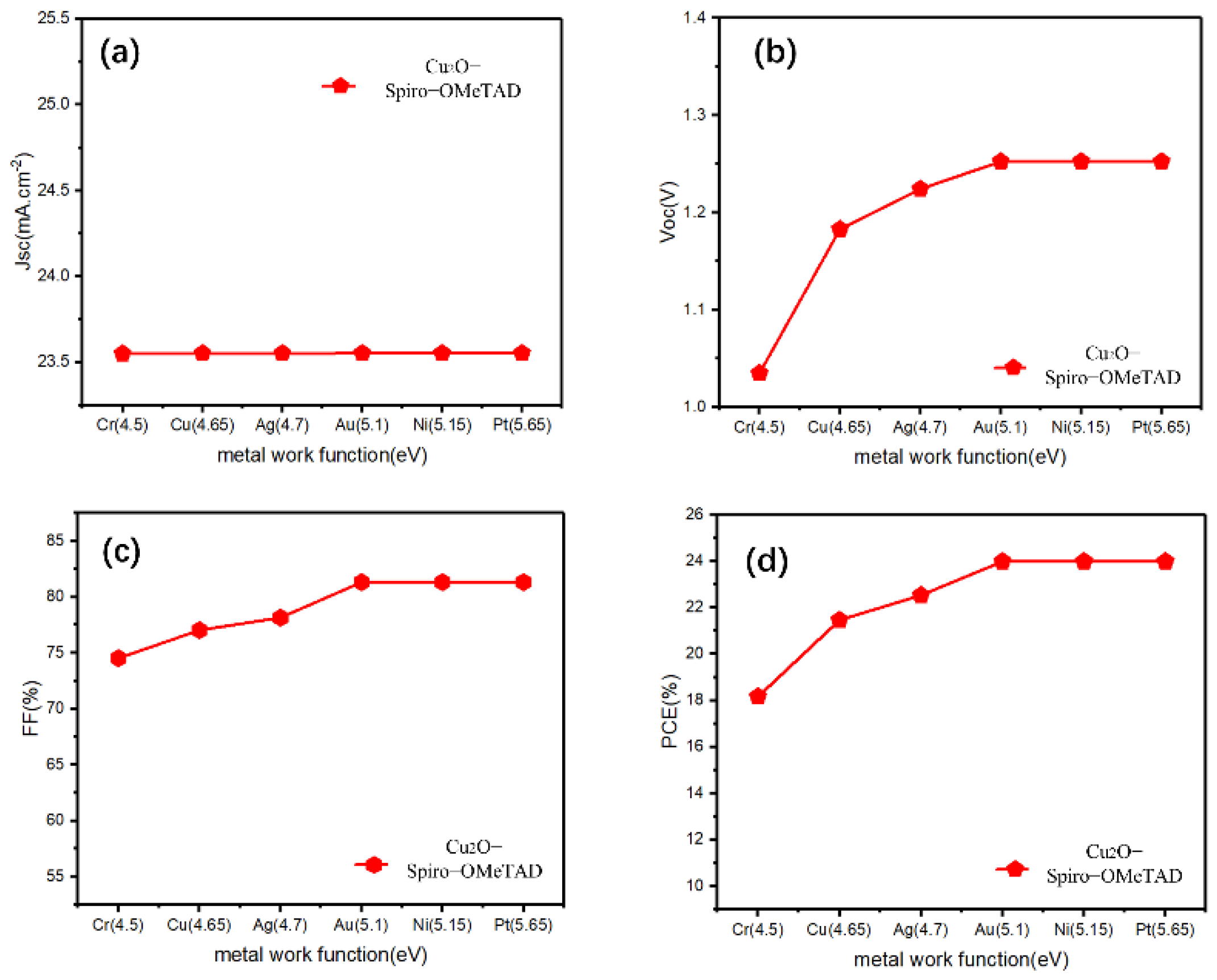
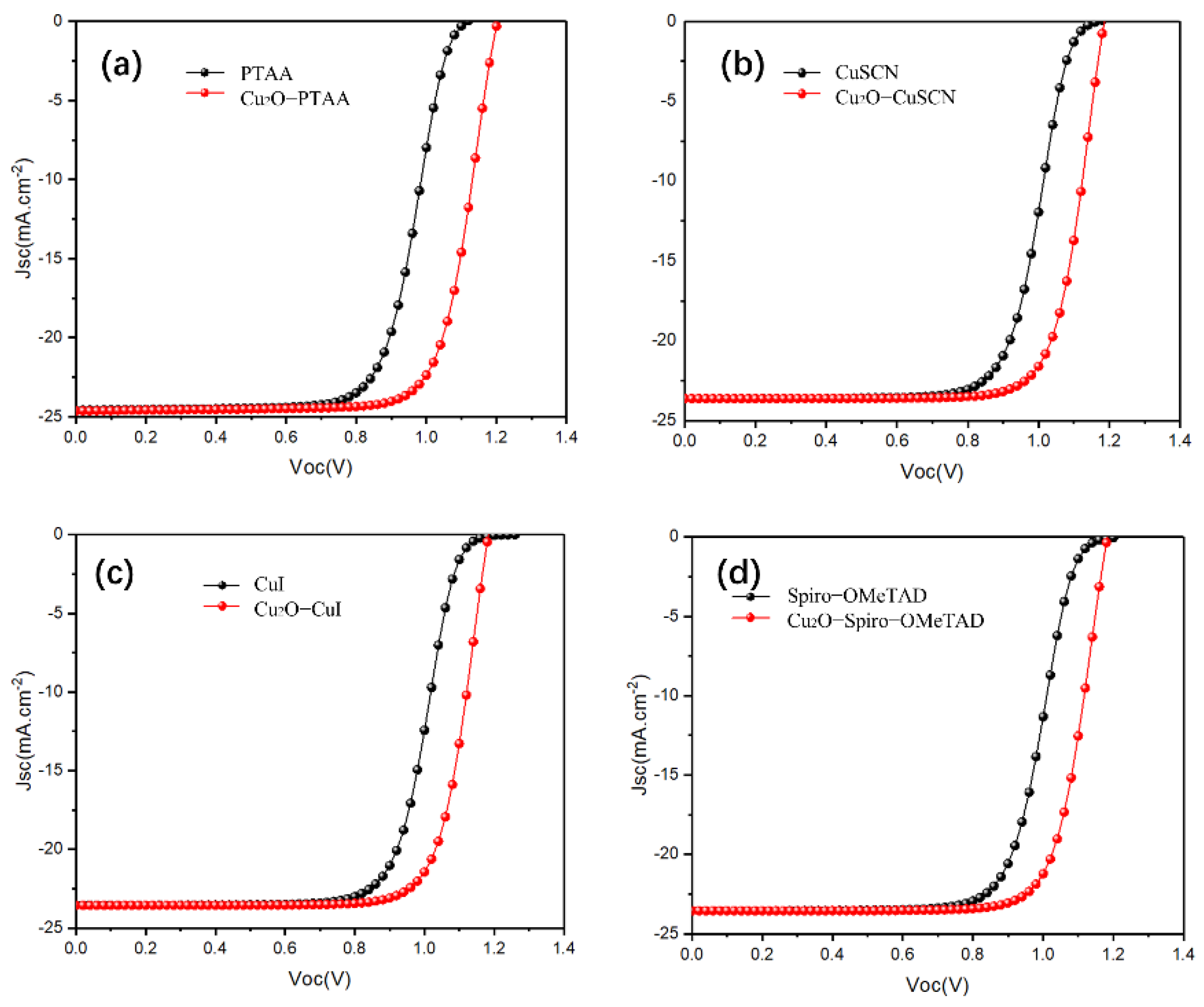
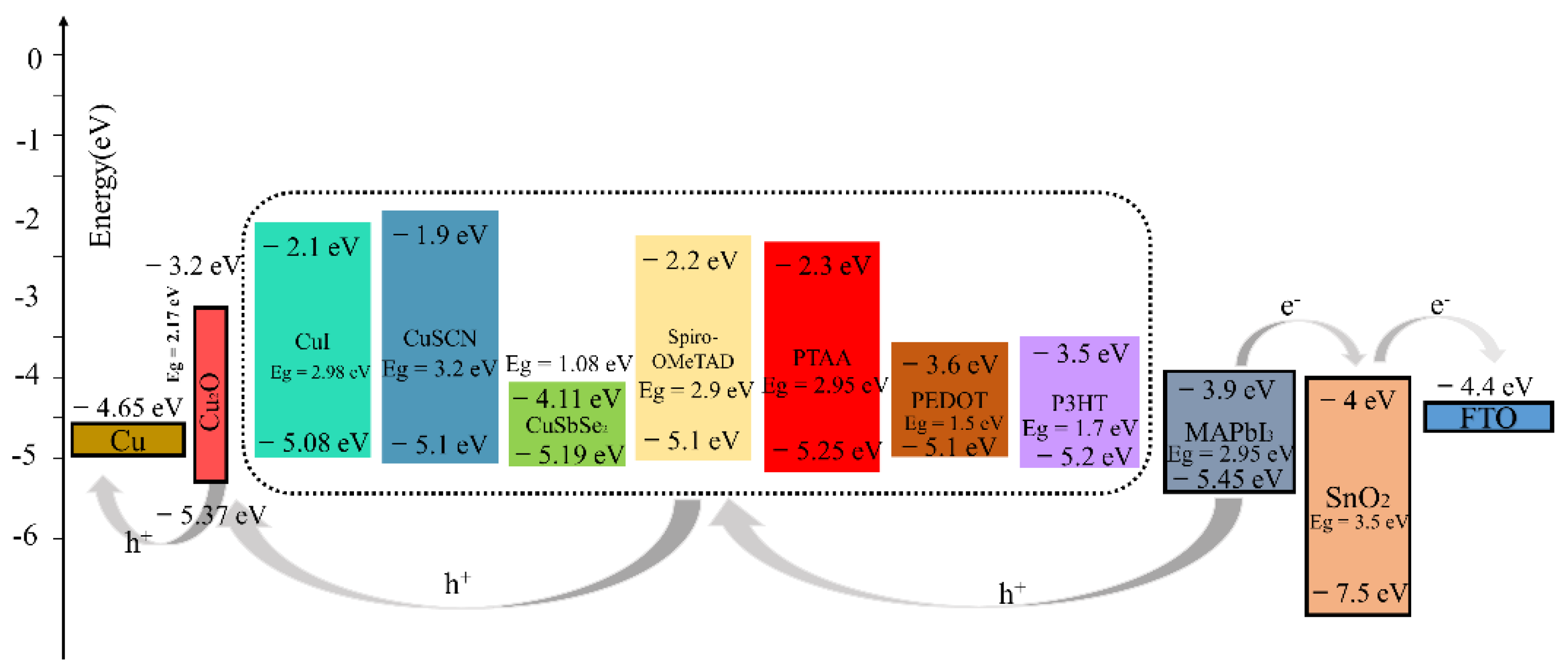
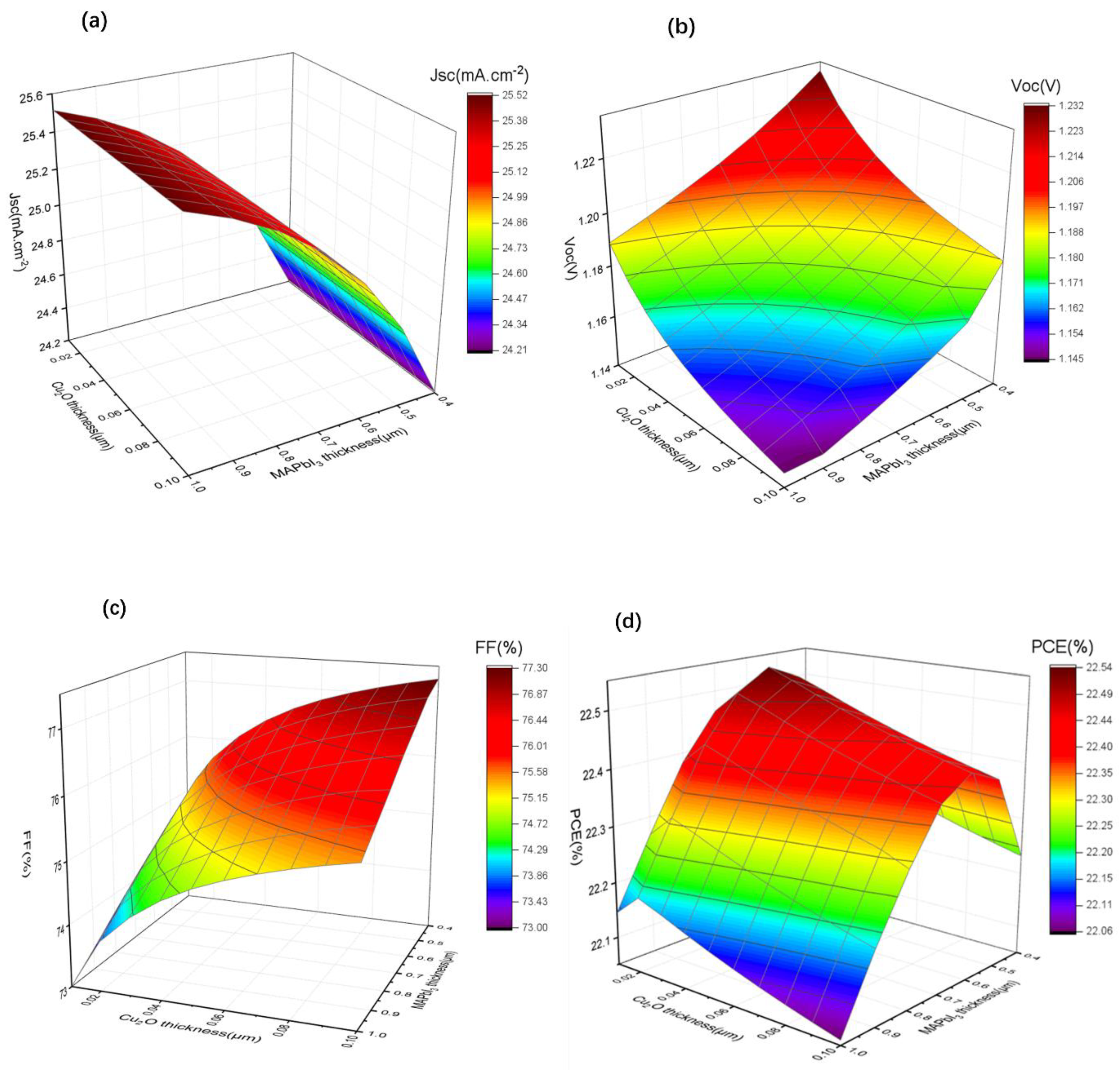
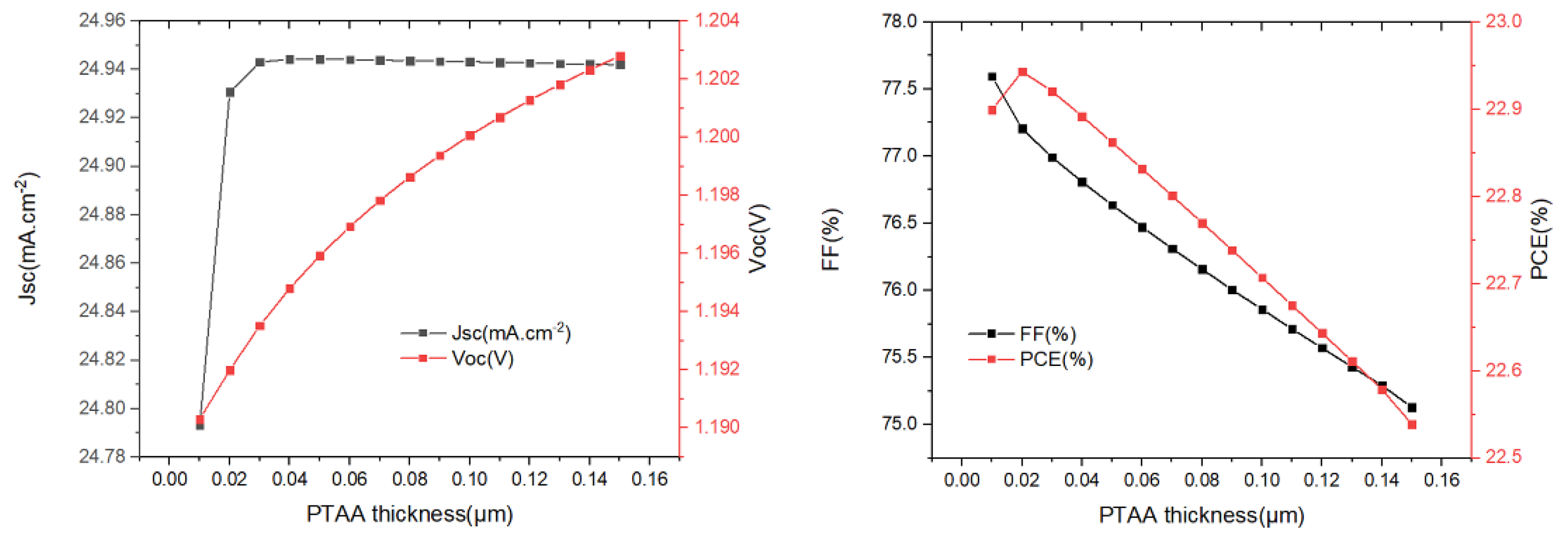
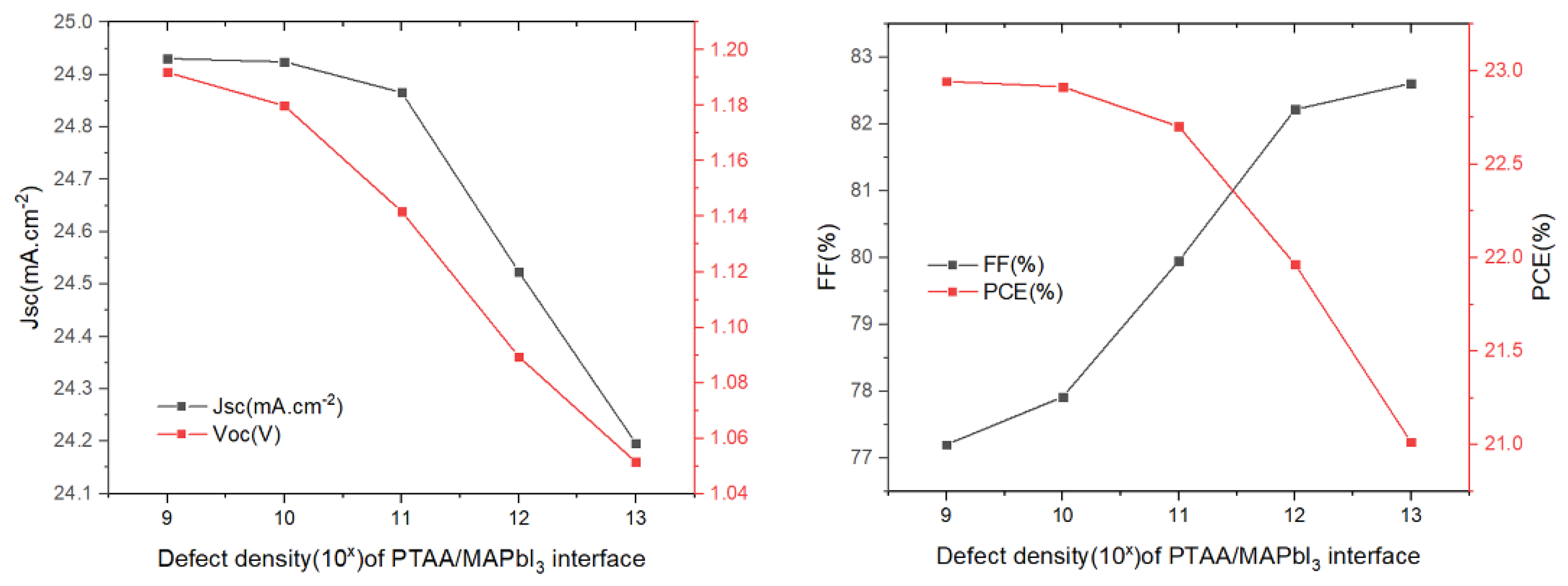
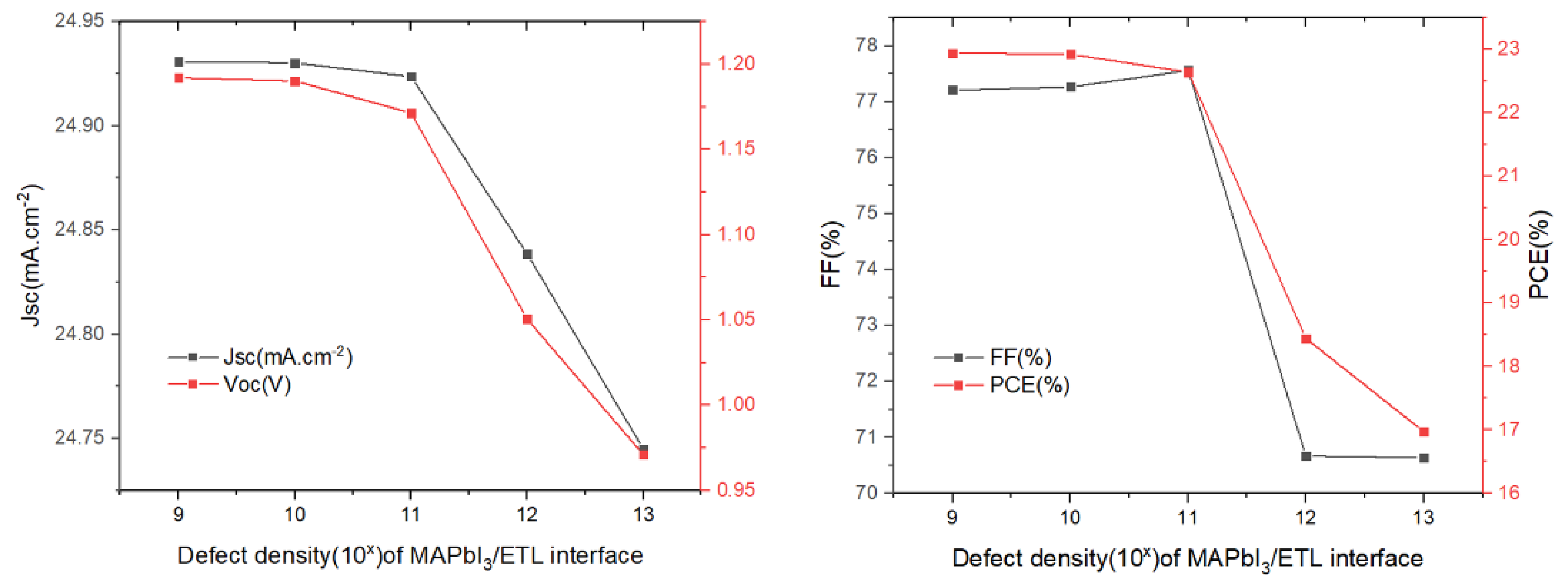
| Parameters | FTO | ETL(SnO2) | MAPbI3 | HTL (Spiro-OMeTAD) | Buffer Layer (Cu2O) |
|---|---|---|---|---|---|
| Thickness (µm) | 0.5 | 0.07 | 0.5 | 0.15 | 0.03 |
| Band gap (eV) | 3.5 | 3.5 | 1.55 | 2.9 | 2.17 |
| E Affinity | 4 | 4 | 3.9 | 2.2 | 3.2 |
| Permittivity | 9 | 9 | 30 | 3 | 7.1 |
| Effective density of states at CB | 2.2 × 1018 | 2.2 × 1018 | 2.2 × 1018 | 2.2 × 1019 | 2.5 × 1020 |
| Effective density of states at VB | 1.8 × 1019 | 1.8 × 1019 | 1.8 × 1019 | 2.2 × 1019 | 2.5 × 1020 |
| Mobility of e− | 20 | 20 | 2 | 1 × 10−4 | 200 |
| Mobility of h+ | 10 | 10 | 2 | 1 × 10−4 | 8600 |
| Density of n-type doping | 2 × 1019 | 1 × 1017 | 0 | 0 | 0 |
| Density of p-type doping | 0 | 0 | 1 × 1013 | 1 × 1018 | 1 × 1018 |
| Thermal velocity of e− | 1 × 107 | 1 × 107 | 1 × 107 | 1 × 107 | 1 × 107 |
| Thermal velocity of h+ | 1 × 107 | 1 × 107 | 1 × 107 | 1 × 107 | 1 × 107 |
| Density of defects | Donor-1 × 1015 | Donor-1 × 1015 | Neutral-2.5 × 1013 | Acceptor-1 × 1015 | Acceptor-1 × 1015 |
| References | [17] | [18,19] | [20] | [21] | [19,22] |
| HTL | Cu2O Buffer Layer | Jsc (mA/cm2) | Voc (V) | FF (%) | PCE (%) |
|---|---|---|---|---|---|
| CuI | without | 23.56 | 1.25 | 81.63 | 24.10 |
| with | 23.56 | 1.25 | 81.63 | 24.10 | |
| [38] | 33.88 | 1.13 | 51.78 | 19.63 | |
| [39] | 21.89 | 1.27 | 83.12 | 23.14 | |
| CuSCN | without | 23.63 | 1.25 | 81.73 | 24.23 |
| with | 23.63 | 1.25 | 81.73 | 24.23 | |
| [19] | 25.62 | 1.19 | 87.81 | 26.74 | |
| [38] | 33.58 | 0.86 | 73.21 | 21.04 | |
| CuSbSe2 | without | 23.48 | 0.74 | 79.97 | 13.97 |
| with | 23.72 | 0.76 | 78.66 | 14.16 | |
| Spiro-OMeTAD | without | 23.55 | 1.25 | 81.32 | 23.99 |
| with | 23.55 | 1.25 | 81.32 | 23.99 | |
| [19] | 25.59 | 1.13 | 81.54 | 23.55 | |
| [40] | 21.74 | 1.15 | 80.90 | 20.23 | |
| PTAA | without | 24.67 | 1.26 | 80.61 | 25.10 |
| with | 24.67 | 1.26 | 80.61 | 25.10 | |
| [41] | 41.03 | 0.78 | 74.14 | 23.58 | |
| PEDOT: PSS | without | 26.29 | 0.94 | 83.84 | 20.80 |
| with | 29.42 | 0.96 | 82.91 | 23.45 | |
| [38] | 28.66 | 1.06 | 62.21 | 18.85 | |
| [39] | 21.89 | 1.27 | 71.43 | 19.88 | |
| P3HT | without | 23.92 | 1.07 | 81.50 | 20.92 |
| with | 26.76 | 1.08 | 74.69 | 21.49 | |
| [19] | 25.56 | 0.97 | 86.52 | 21.52 | |
| [39] | 21.89 | 1.27 | 74.05 | 20.61 |
| Parameters | CuI | CuSCN | CuSbSe2 | PTAA | PEDOT: PSS | P3HT |
|---|---|---|---|---|---|---|
| Thickness (µm) | 0.15 | 0.15 | 0.15 | 0.15 | 0.15 | 0.15 |
| Band gap (eV) | 2.98 | 3.2 | 1.08 | 2.95 | 1.5 | 1.7 |
| E Affinity | 2.1 | 1.9 | 4.11 | 2.3 | 3.6 | 3.5 |
| Permittivity | 6.5 | 10 | 15 | 3.5 | 10 | 3 |
| Effective density of states at CB | 2.8 × 1019 | 2.5 × 1018 | 9.9 × 1020 | 2 × 1021 | 1 × 1021 | 1 × 1022 |
| Effective density of states at VB | 1 × 1019 | 1.8 × 1019 | 9.9 × 1020 | 2 × 1021 | 1 × 1021 | 1 × 1022 |
| Thermal velocity of e− | 1 × 107 | 1 × 107 | 7.3 × 106 | 1 × 107 | 1 × 107 | 1 × 107 |
| Thermal velocity of h+ | 1 × 107 | 1 × 107 | 7.3 × 106 | 1 × 107 | 1 × 107 | 1 × 107 |
| Mobility of e− | 1.69 × 10−4 | 2 × 10−4 | 10 | 1 × 10−4 | 1 | 1.8 × 10−3 |
| Mobility of h+ | 1.69 × 10−4 | 2 × 10−4 | 10 | 1 × 10−4 | 4 | 1.8 × 10−2 |
| Density of n-type doping | 0 | 0 | 0 | 0 | 0 | 0 |
| Density of p-type doping | 1 × 1018 | 1 × 1018 | 5 × 1016 | 1 × 1018 | 3.17 × 1014 | 3.17 × 1013 |
| Density of defects | Acceptor-1 × 1015 | Acceptor-1 × 1015 | Acceptor-1 × 1014 | Acceptor-1 × 1015 | Acceptor-1 × 1014 | Acceptor-1 × 1014 |
| References | [38] | [19,39,47] | [48] | [21,49] | [50,51] | [19,32] |
| HTL | Cu2O Buffer Layer | Jsc (mA/cm2) | Voc (V) | FF (%) | PCE (%) |
|---|---|---|---|---|---|
| CuI | without | 23.56 | 1.25 | 64.88 | 19.13 |
| with | 23.56 | 1.18 | 77.40 | 21.58 | |
| CuSCN | without | 23.62 | 1.17 | 69.29 | 19.10 |
| with | 23.62 | 1.19 | 77.48 | 21.70 | |
| CuSbSe2 | without | 23.45 | 0.73 | 79.74 | 13.64 |
| with | 23.61 | 0.71 | 69.87 | 11.74 | |
| Spiro-OMeTAD | without | 23.55 | 1.22 | 66.07 | 18.92 |
| with | 23.55 | 1.18 | 77.03 | 21.46 | |
| PTAA | without | 24.60 | 1.12 | 69.16 | 18.99 |
| with | 24.64 | 1.20 | 75.92 | 22.49 | |
| PEDOT: PSS | without | 26.05 | 0.73 | 69.80 | 13.30 |
| with | 28.14 | 0.90 | 75.82 | 19.27 | |
| P3HT | without | 23.88 | 0.95 | 76.56 | 17.41 |
| with | 25.49 | 1.02 | 72.09 | 18.67 |
Publisher’s Note: MDPI stays neutral with regard to jurisdictional claims in published maps and institutional affiliations. |
© 2022 by the authors. Licensee MDPI, Basel, Switzerland. This article is an open access article distributed under the terms and conditions of the Creative Commons Attribution (CC BY) license (https://creativecommons.org/licenses/by/4.0/).
Share and Cite
Lin, C.; Liu, G.; Xi, X.; Wang, L.; Wang, Q.; Sun, Q.; Li, M.; Zhu, B.; Lara, D.P.d.; Zai, H. The Investigation of the Influence of a Cu2O Buffer Layer on Hole Transport Layers in MAPbI3-Based Perovskite Solar Cells. Materials 2022, 15, 8142. https://doi.org/10.3390/ma15228142
Lin C, Liu G, Xi X, Wang L, Wang Q, Sun Q, Li M, Zhu B, Lara DPd, Zai H. The Investigation of the Influence of a Cu2O Buffer Layer on Hole Transport Layers in MAPbI3-Based Perovskite Solar Cells. Materials. 2022; 15(22):8142. https://doi.org/10.3390/ma15228142
Chicago/Turabian StyleLin, Chunxiang, Guilin Liu, Xi Xi, Lan Wang, Qiqi Wang, Qiyan Sun, Mingxi Li, Bingjie Zhu, David Perez de Lara, and Huachao Zai. 2022. "The Investigation of the Influence of a Cu2O Buffer Layer on Hole Transport Layers in MAPbI3-Based Perovskite Solar Cells" Materials 15, no. 22: 8142. https://doi.org/10.3390/ma15228142







